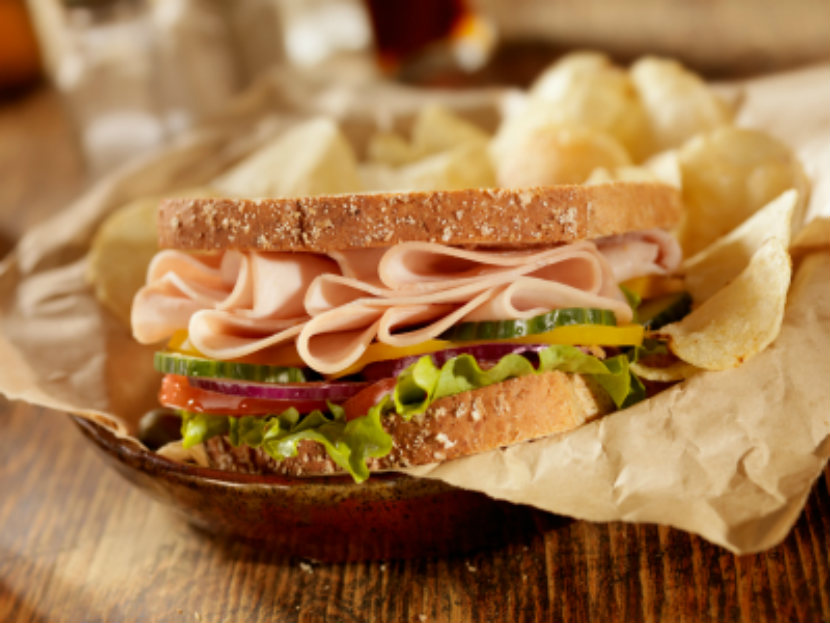
Can you build a healthy sandwich? The building blocks of a nutritious sandwich start by choosing the right bread and fillings. But, it’s easy to go overboard on salty and fatty options. From the bread through to the fixings, here are some tips for making a healthier sandwich.
The bread
Consider switching your white bread for a more nutritious whole grain option. Why? Because whole grains may help reduce the risk of heart disease, diabetes and certain cancers. Choose bread that lists whole grain as the first ingredient. Also look for bread with at least two grams of fibre per slice.
Don’t be fooled by words like “cracked wheat,” or “multigrain.” If it doesn’t say whole grain, it probably isn’t. Dark-coloured or brown breads may also not be whole grain – they may just be coloured with molasses.
There are more options besides sliced bread! Go for bagels, pita, tortillas or naan. All come in whole grain versions. Read ingredient lists to know for sure. Look for the words “whole grain” as the first ingredient on the list.
The protein in your sandwich
Whether you stack your sandwich with meat, cheese or egg salad, it’s important to have a source of protein between the bread. Protein is necessary for building and repairing muscle and tissue. Plus, high protein foods help you feel full, which helps if you are trying to manage your weight.
Meat: Make extra roast beef or chicken at dinner and use leftovers in sandwiches. Home cooked meats have less sodium than deli meat, and won’t contain as many preservatives. If you do buy deli meat, read the ingredient list and choose one that does not include “nitrites.” (Nitrites are added to prevent bacteria growth but they may increase the risk of some cancers). Use the Nutrition Facts panel to compare and choose deli meat with the lowest sodium and fat content. Try to make deli meats a once in awhile treat.
Cheese: When buying sliced cheese, look at the milk fat (MF) content. Buy reduced fat or lower fat cheeses with less than 20% MF. To limit sodium, choose fresh instead of processed cheese. A slice of processed cheese has 740 mg of sodium, while fresh cheddar has just 210 mg.
Meat alternatives: If you are mashing egg, salmon or tuna, cut back on full-fat mayonnaise. Use light mayo or low–fat yogurt instead.
Try something new! Beans, nuts and seeds make nutritious sandwich fillings. Use edamame or lentils to stuff a pita. Blend chickpeas with garlic to create your own chunky hummus with less fat and salt than the store-bought kind. For a change from peanut butter, try almond, hazelnut or cashew butter. If allergies are a concern, choose school-safe soy nut or sunflower seed butter.
Stick with sensible serving sizes to control calories:
|
Sandwich filling
|
Serving size
|
|
Meat or poultry
|
75 grams (size of a deck of cards)
|
|
Cheese
|
50 grams (2 slices)
|
|
Fish
|
75 grams (½ can drained)
|
|
Eggs
|
2 large
|
|
Beans, lentils
|
¾ cup
|
|
Nut or seed butter
|
2 tbsp
|
Sandwich toppings
Build the health value of your sandwich with lots of veggies. Vegetables provide vitamins, minerals, fibre, and are low in calories. Beyond lettuce and tomato, these toppings provide a unique twist:
-
Red pepper and cucumber rings
-
Shredded carrots or beets
-
Kale, arugula or baby spinach
-
Grilled zucchini or eggplant
-
Fresh basil, parsley or coriander
Fruit is great on sandwiches too! How about a Soy butter and banana roll, tuna with sliced peaches, or low-fat cheddar with apple?
Sandwich spreads
Skip butter and choose avocado. It is high in heart-healthy monounsaturated fats and adds rich flavour to sandwiches. Low fat mayonnaise, oil-based vinaigrettes and non-hydrogenated margarine also contain healthy fats. But be aware that with any of these options, the calories and fat add up quickly. Use only a little at a time – no more than a teaspoon or two per sandwich.
Ketchup, salsa and mustard are lower calorie, fat-free options. However they may be high in sodium. Limit your serving size to one or two teaspoons. Try wasabi (Japanese mustard) or horseradish if you like it hot – they have less sodium than other spreads.
Sodium content in common condiments
|
Condiment
|
Sodium per 1 tbsp (15 mL)
|
|
Yellow mustard
|
179 mg
|
|
Dijon mustard
|
204 mg
|
|
Wasabi
|
1 mg
|
|
Horseradish
|
48 mg
|
|
Ketchup
|
169 mg
|
|
Salsa
|
100 mg
|
|
Hummus
|
54 mg
|
Bottom line
You are the builder of your healthy sandwich. Begin with a nutritious base of whole grain bread. Add a healthy source of protein (but not too much of it), loads of crunchy vegetables and a savoury sauce that’s filled with zip but not sodium.
Sandwich Recipes
Chicken Salad Sandwich - Two Ways
Chicken Tzatziki Roll Ups
Mango Chicken Wraps
Last Update – May 10, 2017